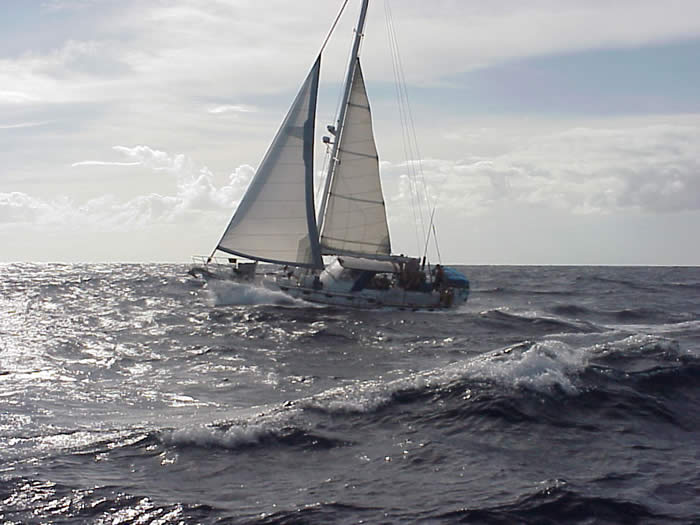Kama Hele - The Ultimate Escort Vessel
Sam Low
On most of her voyages, Hokule'a has been escorted by a 45 foot steel sloop called Kama Hele - the floating home of Elsa and Alex Jakubenko.

Elsa and Alex, 1999
Kama Hele was built by Alex, who first began constructing sailing yachts and fishing boats in Australia in 1949. "Kama Hele" means "Traveler" as well as "A strong branch off of the trunk of a tree," an apt description of the escort boat that has accompanied Hokule'a on its last three voyages.

Kama Hele. Photo by Sam Low
Alex and Elsa's first encounter with The Polynesian Voyaging Society began in a roundabout way in 1972, when they moved to Taiwan to build a 65 foot ketch, Meotai. Meotai was launched in 1974 and eventually purchased from the original owner by Honolulu business man Bob Burke who would use her as Hokule'a's escort vessel in the first historic voyage to Tahiti.
In 1976, when Hokule'a' arrived in Tahiti, Alex and Elsa were there aboard an earlier Jakubenko built sloop called Ishka. "I saw the tremendous reception that the Tahitians gave the canoe," Alex remembers, "you would have to be there to believe it. Within twenty-four hours there were at least twenty new songs about the canoe. The voyage gave the people so much pride and excitement that both Elsa and I wanted to do something to help. But at the time, we had no idea what."
Later that year, the couple returned to Hawaii where Alex worked at Ke'ehi Dry dock where Hokule'a was brought for overhaul after the 1976 voyage and for repair after she capsized on her 1978 trip to Tahiti.
In 1980, Alex and Elsa began to escort Hokule'a with Ishka. While towing the canoe to Hilo for her departure to Tahiti, Ishka and Hokule'a were struck by a terrible storm. Even with Ishka's engines going at full speed, she could not make headway and, for a time, the two vessels were in danger of being wrecked off the Hamakua coast of the Big Island. Fortunately, good seamanship on both escort and canoe saved the day. "If it were not for Ishka and Alex, Hokule'a might not be here today," says navigator Bruce Blankenfeld. This near disaster would provide valuable experience once Alex began to build Kama Hele.
Sailing aboard Ishka, Alex and Elsa were with Hokule'a all the way on the 1980 voyage to Tahiti and back during which Nainoa, under the watchful eyes of Mau Piailug, navigated the canoe for the first time.
During the next ten years, while other escort vessels followed in the wake of Hokule'a, Alex turned his attention to building steel trawlers. But he kept thinking about his experiences and the unique needs of the escort mission. In 1991, When Nainoa asked him if he would escort Hokule'a on the voyage to Rarotonga for the Arts Festival there in 1992, Alex said yes. But he would do so with a completely new vessel, one custom built for escort duty.
In 1991, Alex laid the keel for what he hoped would be the "ultimate escort vessel" - Kama Hele. Working with a basic design by marine architect Bruce Roberts, Alex made many changes to adapt the vessel for her duties with Hokule'a. "When I thought about the design of this vessel," Alex says, "I tried to remember everything that we did right with the earlier vessels and ways to improve on our mistakes. The vessel had to meet all the requirements of escorting the canoe so that it would never fail in her mission, and that meant being able to take a tow in all kinds of weather." In addition, the escort had to be small enough so that she would not overshadow the canoe yet large enough to carry sufficient fuel for the duration of the trip. "She should also," Alex explained, "have plenty of room for her crew and, if necessary, for the crew of the Hokule'a. And she must be fast enough so as to never slow down the canoe."

Alex steering, 2000. Photo by Sam Low
The vessel that took shape in Alex's yard - Hawaiian Steel Boatbuilding - was a 45 foot sloop with a graceful sheer line from bow to stern. She was equipped with fuel tanks that could carry 1700 gallons of diesel, enough to allow her to steam up to 5000 miles without refueling. She is powered by a Detroit 371 diesel engine that Alex describes as "old fashioned, the kind they use in tanks or landing craft. But it will go forever and it is simple to maintain." The engine turns a propeller that is 29 inches in diameter, at least three times the normal size, one that Alex took from a 44 foot tugboat. Kama Hele carries a desalinator that is capable of producing 40 gallons of fresh water a day, more than enough for the crew of the canoe and escort combined. She is fully equipped with the latest radio and navigational gear. "The wiring was a difficult job and I needed help for that," Alex explains, "so Jerry Ongies came down and spent a lot of time making sure that everything was done just right." Also assisting Alex to meet his launch deadline were Paul Fukunaga and Jeff Merrik.
In 1992, on schedule, the new 45 foot sloop Kama Hele departed with Hokule'a and set her course south to the Cook Islands, returning to Hawaii after a successful voyage. In 1995, Kama Hele once again headed south, this time in the company of two canoes, Hokule'a and Hawai'iloa, on yet another voyage to Tahiti where they would join up with a fleet of canoes from the Cook Islands, Aoteroa (New Zealand) and Tahiti, as well as one other canoe, Makali'i, from Hawaii. Departing Tahiti on the return trip, Kama Hele proved her mettle as a mini tug by towing two canoes simultaneously, Hawai'iloa and Teaurere, from Tahiti to the Marquesas - all the way into strong headwinds. From the Marquesas to Hawaii, Kama Hele escorted Hawai'iloa and shortly after reaching port, she turned around and escorted the Cook Island canoe, Taki Tumu back to Rarotonga.
"Elsa and Alex are at sea more than any of us," says Nainoa Thompson, "they have both proven over and over again that they are totally committed to the mission of our voyages."
"You might be able to find someone to go on escort duty who had a good boat," says Bruce Blankenfeld, "but you would not find a captain like Alex. When he says he will do something, you can be absolutely certain that it will be done."
In 1998, when Nainoa once again asked Alex and Elsa if they would agree to serve one last time, the couple could be forgiven if they had demurred. Alex and Elsa were then both in heir late 70s. But, after due consideration, they agreed to take on the challenge.
"Well, you know, even at my age a person looks for a little adventure. It can get pretty boring sometimes in Honolulu," Elsa says when explaining why she decided to come on what may be the most difficult voyage of all.
